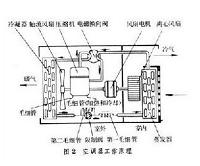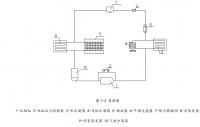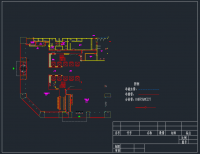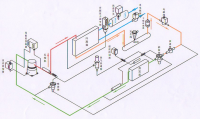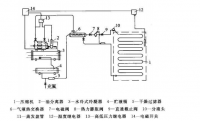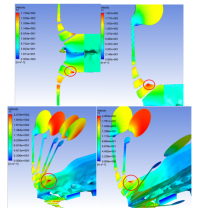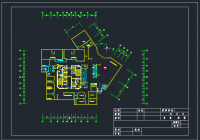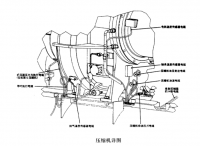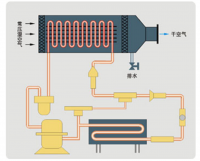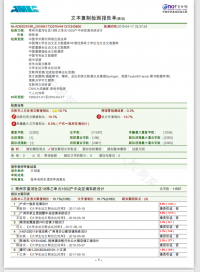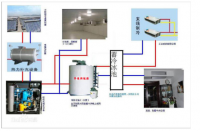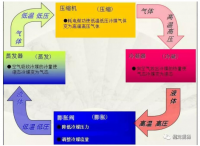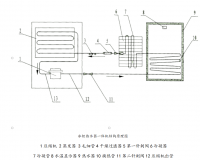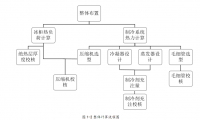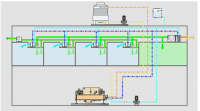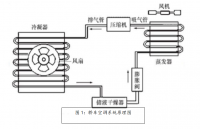空气调节的讨论(制冷论文)
第一 ,人体的舒适
Heating and air conditioning systems use the principles of heat transfer to maintain comfortable indoor conditions for people.
供热及空调系统是使用换热的原则来维护人舒适室内条件。
The three basic principles of heat transfer discussed in this clinic are:
这个计算讨论的是传热的三个基本原则:
1) Heat energy cannot be destroyed; it can only be transferred to another substance.
1 )能量不能主动消失,只能被转移到另一物质。
To produce cooling, heat must be removed from a substance by transferring the heat to another substance. This is commonly referred to as the principle of “conservation of energy.” Ice cubes are typically placed in a beverage to cool it before being served. As heat is transferred from the beverage to the ice, the temperature of the beverage is lowered. The heat removed from the beverage is not destroyed, but instead is absorbed by the ice, melting the ice from a solid to a liquid.
若要生产冷却,热必须从一种物质的热转移到另一种物质。 这是通常称为 “ 节约能源 ” 的原则。 冰块通常是放置在一个饮料降温之前送达。由于热量是由饮料传到冰块,饮料的温度会降低。从饮料中传出的热量并不是被销毁,而是被冰块吸收,把冰从固体融化成液体。
2) Heat energy naturally flows from a higher-temperature substance to a lower-temperature substance, in other words, from hot to cold.
2 )热能源的自然流动从更高的高温物质到低温物质,换句话说是从热到冷。
Heat cannot naturally flow from a cold substance to a hot substance. Consider the example of the beverage and the ice cubes. Because the temperature of the beverage is higher than the temperature of the ice cubes, heat will always flow from the beverage to the ice cubes.
热量不能自然流到比它自身温度低的物体上。就拿饮料和冰块的例子来说,由于饮料的温度高于冰块温度,热量将永远不会从饮料流向冰块。
3) Heat energy is transferred from one substance to another by one of three basic processes: conduction, convection, or radiation.
3 )热量从一个物质传到另外一个物质分有三种方式:传导,对流或辐射。
The device shown is a baseboard convector that is commonly used for heating a space. It can be used to demonstrate all three processes of transferring heat.
该器件显示是一个基板变换器,是常用的空间供暖。它可以用来证明所有这三个程序转移热量。
Hot water flows through a tube inside the convector, warming the inside surface of the tube. Heat is transferred, by conduction, through the tube wall to the slightly cooler fins that are attached to the outside surface of the tube. Conduction is the process of transferring heat through a solid. The heat is then transferred to the cool air that comes into contact with the fins. As the air is warmed and becomes less dense, it rises, carrying the heat away from the fins and out of the convector. This air movement is known as a convection current. Convection is the process of transferring heat as the result of the movement of a fluid. Convection often occurs as the result of the natural movement of air caused by temperature (density) differences.
热水流经管内变换器,使管的内表面变暖。 热被传导转移,通过附加到管的外表面的轻微冷却器翅片管墙。 传导是通过一个固体热转移的过程。热然后转移到凉爽的空气,接触到的翅片。由于空气变得温暖和密度较低,它的上升,携带热源远离翅片和出变换器。这空气流动被称为对流。对流过程中的热量转移的结果,运动的流体。对流经常发生的结果自然运动所造成的空气温度(密度)的差异。
Additionally, heat is radiated from the warm cabinet of the convector and warms cooler objects within the space. Radiation is the process of transferring heat by means of electromagnetic waves, emitted due to the temperature difference between two objects. An interesting thing about radiated heat is that it does not heat the air between the source and the object it contacts; it only heats the object itself.
此外,热辐射是变换空间物体的温差冷却器。辐射是热传递过程中通过电磁波,排放到两个物体的温差。一个辐射热,它不加热空气之间的来源和它接触的对象,只加热物体本身。
In the I-P system of units, the unit for measuring the quantity of heat is the British Thermal Unit (Btu). The Btu is defined as the quantity of heat energy required to raise the temperature of 1 lb of water 1°F.
在知识产权制度的单位,测量数量单位是英国热单位(英热单位) 。英热单位被定义为提高温度的水 1 °•1 磅的所需的热能的数量。
Similarly, in the Système International (SI) system, heat quantity can be expressed using the unit kiloJoule (kJ). A kcal is defined as the amount of heat energy required to raise the temperature of 1 kg of water 1°C. One kcal is equal to 4.19 kJ.
同样,在国际体系( SI )的系统,热量可以表示使用单位千焦耳(热) 。大卡的定义是的热量所需的能源,以提高温度1公斤水1 ° C的1大卡等于4.19千焦。
In heating and cooling applications, however, emphasis is placed on the rate of heat transfer, that is, the quantity of heat that flows from one substance to another within a given period of time. This rate of heat flow is commonly expressed in terms of Btu/hr—the quantity of heat, in Btu, that flows from one substance to another during a period of 1 hour.
在加热和冷却的应用,被重点放在换热率的就是在给定的时间内热量的流动从一个物质到另一个的热的数量。这热流率通常表示为英热单位/小时-热,在热值,即1个小时期间从一个物质流入到另一个物质的数量。
Similarly, in the SI system of units, the rate of heat flow is expressed in terms of kilowatts (kW). One kW is equivalent to 1 kJ/sec. One kilowatt describes the quantity of heat, in kJ, that flows from one substance to another during a period of 1 second. Finally, the rate of heat flow may often be expressed in terms of watts (W). One kW is equivalent to 1000 W.
同样,在国际单位制中,热量的单位是千瓦(KW) 。一千瓦,相当于1千焦耳/秒。 1千瓦表示的热量(一千焦耳),从一个物质流入到另外一个物质的期间单位面积通过的热量为1千焦,1千焦相当于1000焦。
The process of comfort heating and air conditioning is simply a transfer of energy from one substance to another. This energy can be classified as either sensible or latent heat energy.
这一过程的适合的热量和空调只是将能量从一侧转换到另一侧。这种能量可分为显热或潜热。
Sensible heat is heat energy that, when added to or removed from a substance, results in a measurable change in dry-bulb temperature.
显热是当能量增加或者消失的时候,导致在干球温度的平衡。
Changes in the latent heat content of a substance are associated with the addition or removal of moisture. Latent heat can also be defined as the “hidden” heat energy that is absorbed or released when the phase of a substance is changed. For example, when water is converted to steam, or when steam is converted to water.
变化中的潜热的物质能够增加或去除湿气。潜热也可以被界定为“隐藏”热能的吸收或释放的阶段而导致物质的变化。例如,当水转化为蒸汽,或当蒸汽转化为水。
The necessity for comfort air conditioning stems from the fact that the metabolism of the human body normally generates more heat than it needs. This heat is transferred by convection and radiation to the environment surrounding the body. The average adult, seated and working, generates excess heat at the rate of approximately 450 Btu/hr [132 W]. About 60% of this heat is transferred to the surrounding environment by convection and radiation, and 40% is released by perspiration and respiration.
舒适性空调必备的条件,即满足代谢人体的舒适性所需要的温度。这种热量转换是通过对流或者辐射的方式影响到周围的环境。以一个普通成年人坐着工作为例,会产生多余的热量的速度大约为450 英热单位 /小时[ 132瓦] 。约60 %的热量通过对流和辐射转移到周围的环境, 剩余的40 %是由汗水和呼吸。
As the level of physical activity increases, the body generates more heat in proportion to the energy expended. When engaged in heavy labor, as in a factory for example, the body generates 1,450 Btu/hr [425 W]. At this level of activity, the proportions reverse and about 40% of this heat is transferred by convection and radiation and 60% is released by perspiration and respiration. In order for the body to feel comfortable, the surrounding environment must be of suitable temperature and humidity to transfer this excess heat. If the temperature of the air surrounding the body is too high, the body feels uncomfortably warm. The body responds by increasing the rate of perspiration in order to increase the heat loss through evaporation of body moisture. Additionally, if the surrounding air is too humid, the air is nearly saturated and it is more difficult to evaporate body moisture.
这个过程是通过汗水的蒸发,以增加热量损失的过程,通过蒸发水分。此外,如果周围的空气太潮湿,空气接近饱和,而且更难以蒸发体内的水分。由于身体活动量的增加,身体会产生更多的热量比例的能源支出。例如在从事繁重的劳动,因为在工厂,人体会产生1450 英热单位 /小时[ 425瓦] 。在这一级别的活动,通过对流和辐射转换和比例约40 %, 60 %是由汗水和呼吸。为了让身体感觉舒适,周围的环境必须具有合适的温度和湿度,以消除这种过热。如果周围的空气温度高于人体温度,身体感觉不舒服。
If the temperature of the air surrounding the body is too low, however, the body loses more heat than it can produce. The body responds by constricting the blood vessels of the skin to reduce heat loss.
如果空气温度低于身体温度,然而,人体失去的热量高于自身产生的热量。身体作出反应,收缩皮肤的血管,以减少热损失。
The term “comfort” is often used to define a broader set of conditions than just temperature and humidity. Air movement, adequate fresh air, cleanliness of the air, noise levels in the space, adequate lighting, and proper furniture and work surfaces, are just a few of the other variables that contribute to making a space comfortable for its occupants. This clinic, however, will focus only on the aspects of thermal comfort.
术语“舒适”是经常被用来定义一个更广泛的条件不仅仅是温度和湿度。空气流动,充分呼吸新鲜空气,洁净的空气,空间的噪音,足够的照明和适当工作环境,这个诊所仅仅是几个其他变数,有助于使空间舒适的居住条件。,但是,只注重各方面热舒适。
Thermal comfort depends on creating an environment of dry-bulb temperature, humidity, and air motion, that is appropriate for the activity level of the people in the space. This environment allows the body’s rate of heat generation to balance with the body’s rate of heat loss.
热舒适性取决于环境干球温度创造条件,湿度和空气的方案,这是适合人舒适性的空间。这种环境使人体的利率所产生的热量平衡与人体的热损失率。
Research studies have been conducted to show that, with a specific amount of air movement, thermal comfort can be produced with certain combinations of dry-bulb temperature and relative humidity. When plotted on a psychrometric chart, these combinations form a range of conditions for delivering acceptable thermal comfort to 80% of the people in a space. This “comfort zone” and the associated assumptions are defined by ASHRAE Standard 55, Thermal Environmental Conditions for Human Occupancy.
研究已进行了表明,在特定数量的空气流动,舒适性可以生产的某些组合干球温度和相对湿度进行研究。 当在焓湿图表的绘制,这些组合形成了一系列的条件,提供可接受的热舒适性,以80 %的人在一个空间。这种相关的假设和采暖标准 55 人的入住热环境条件的定义此 “ 舒适区域 ”。
Determining the desired condition of the space is the first step in estimating the cooling and heating loads for the space. In this clinic, we will choose 78ºF [25.6ºC] dry-bulb temperature and 50% relative humidity (A) as the desired indoor condition during the cooling season.
确定所需的条件的空间,第一步估计制冷和供热负荷的空间。在这计算里,我们将选择78 º F [ 25.6 º C]干球温度和相对湿度50 % (A)作为理想的室内冷却条件。

微信


QQ1:3097331788 QQ2:2601997959 QQ3:2993773635


